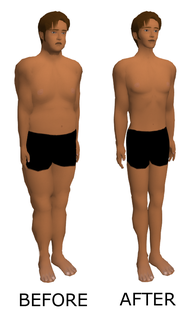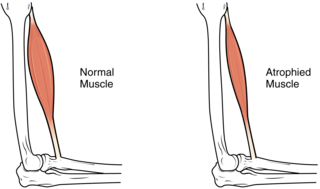Anticachexia (AN-tee-kuh-KEK-see-uh) is a drug or effect that works against cachexia (loss of body weight and muscle mass).
An antiemetic is a drug that is effective against vomiting and nausea. Antiemetics are typically used to treat motion sickness and the side effects of opioid analgesics, general anaesthetics, and chemotherapy directed against cancer. They may be used for severe cases of gastroenteritis, especially if the patient is dehydrated.
Appetite is the desire to eat food, sometimes due to hunger. Appealing foods can stimulate appetite even when hunger is absent, although appetite can be greatly reduced by satiety. Appetite exists in all higher life-forms, and serves to regulate adequate energy intake to maintain metabolic needs. It is regulated by a close interplay between the digestive tract, adipose tissue and the brain. Appetite has a relationship with every individual's behavior. Appetitive behaviour also known as approach behaviour, and consummatory behaviour, are the only processes that involve energy intake, whereas all other behaviours affect the release of energy. When stressed, appetite levels may increase and result in an increase of food intake. Decreased desire to eat is termed anorexia, while polyphagia is increased eating. Dysregulation of appetite contributes to anorexia nervosa, bulimia nervosa, cachexia, overeating, and binge eating disorder.

Cachexia is a complex syndrome associated with an underlying illness causing ongoing muscle loss that is not entirely reversed with nutritional supplementation. A range of diseases can cause cachexia, most commonly cancer, congestive heart failure, chronic obstructive pulmonary disease, chronic kidney disease and AIDS. Systemic inflammation from these conditions can cause detrimental changes to metabolism and body composition. In contrast to weight loss from inadequate caloric intake, cachexia causes mostly muscle loss instead of fat loss. Diagnosis of cachexia can be difficult due to the lack of well-established diagnostic criteria. Cachexia can improve with treatment of the underlying illness but other treatment approaches have limited benefit. Cachexia is associated with increased mortality and poor quality of life.

Weight loss, in the context of medicine, health, or physical fitness, refers to a reduction of the total body mass, by a mean loss of fluid, body fat, or lean mass. Weight loss can either occur unintentionally because of malnourishment or an underlying disease, or from a conscious effort to improve an actual or perceived overweight or obese state. "Unexplained" weight loss that is not caused by reduction in calorific intake or exercise is called cachexia and may be a symptom of a serious medical condition. Intentional weight loss is commonly referred to as slimming.
Sarcopenia is a type of muscle loss that occurs with aging and/or immobility. It is characterized by the degenerative loss of skeletal muscle mass, quality, and strength. The rate of muscle loss is dependent on exercise level, co-morbidities, nutrition and other factors. The muscle loss is related to changes in muscle synthesis signalling pathways. It is distinct from cachexia, in which muscle is degraded through cytokine-mediated degradation, although both conditions may co-exist. Sarcopenia is considered a component of frailty syndrome. Sarcopenia can lead to reduced quality of life, falls, fracture, and disability.

Muscle atrophy is the loss of skeletal muscle mass. It can be caused by immobility, aging, malnutrition, medications, or a wide range of injuries or diseases that impact the musculoskeletal or nervous system. Muscle atrophy leads to muscle weakness and causes disability.

Megestrol acetate (MGA), sold under the brand name Megace among others, is a progestin medication which is used mainly as an appetite stimulant to treat wasting syndromes such as cachexia. It is also used to treat breast cancer and endometrial cancer, and has been used in birth control. MGA is generally formulated alone, although it has been combined with estrogens in birth control formulations. It is usually taken by mouth.

Growth/differentiation factor 15 (GDF15) was first identified as Macrophage inhibitory cytokine-1 or MIC-1.
Malnutrition–inflammation complex (syndrome) (MICS), also known as malnutrition–inflammation–cachexia syndrome, is a common condition in chronic disease states such as chronic kidney disease and chronic heart failure.
Tanezumab is a monoclonal antibody against nerve growth factor as a treatment for pain. Tanezumab was discovered and developed by Rinat Neuroscience and was acquired by Pfizer in 2006.
FACES syndrome is a syndrome of unique facial features, anorexia, cachexia, eye and skin anomalies.

Hydrazine sulfate, more properly hydrazinium hydrogensulfate, is a salt of the cation hydrazinium and the anion bisulfate (hydrogensulfate), with the formula [N
2H+
5][HSO−
4] or N
2H
6SO
4. It is a white, water-soluble solid at room temperature.
An orexigenic, or appetite stimulant, is a drug, hormone, or compound that increases appetite and may induce hyperphagia. This can be a medication or a naturally occurring neuropeptide hormone, such as ghrelin, orexin or neuropeptide Y, which increases hunger and therefore enhances food consumption. Usually appetite enhancement is considered an undesirable side effect of certain drugs as it leads to unwanted weight gain, but sometimes it can be beneficial and a drug may be prescribed solely for this purpose, especially when the patient is suffering from severe appetite loss or muscle wasting due to cystic fibrosis, anorexia, old age, cancer or AIDS. There are several widely used drugs which can cause a boost in appetite, including tricyclic antidepressants (TCAs), tetracyclic antidepressants, natural or synthetic cannabinoids, first-generation antihistamines, most antipsychotics and many steroid hormones. In the United States, no hormone or drug has currently been approved by the FDA specifically as an orexigenic, with the exception of Dronabinol, which received approval for HIV/AIDS-induced anorexia only.

The Journal of Cachexia, Sarcopenia and Muscle is a quarterly peer-reviewed medical journal that covers research relevant to changes in body composition, especially cachexia and sarcopenia, as consequences of chronic illnesses or of the aging process, respectively. It was established in 2010 and was originally published by Springer Science+Business Media. As of January 2015, the journal is published by Wiley-Blackwell in association with the Society on Sarcopenia, Cachexia and Wasting Disorders. The founding editors-in-chief are Stefan D. Anker and Stephan von Haehling. As of November 2016, the journal has two daughter journals entitled JCSM - Clinical Reports and JCSM - Rapid Communications, dedicated to clinical and basic science, respectively.

Anamorelin (INN), also known as anamorelin hydrochloride, is a non-peptide, orally-active, centrally-penetrant, selective agonist of the ghrelin/growth hormone secretagogue receptor (GHSR) with appetite-enhancing and anabolic effects which is under development by Helsinn Healthcare SA for the treatment of cancer cachexia and anorexia.
Juven is a medical food that is manufactured by Abbott Laboratories and used to provide nutritional support under the care of a physician in individuals with muscle wasting due to AIDS or cancer, to promote wound healing following surgery or injury, or when otherwise recommended by a medical professional. It is a powdered nutritional supplement that contains 3 grams of calcium β-hydroxy β-methylbutyrate, 14 grams of L-arginine, and 14 grams of L-glutamine per two daily servings.
The Society on Sarcopenia, Cachexia and Wasting Disorders (SCWD) is an international and multidisciplinary non-profit organization, created in 2008. It focuses on Cachexia and Sarcopenia.

Stefan D. Anker is Head of Field “Tissue Homeostasis and Cachexia" at Charité University, Berlin, Germany. Previously, he was Professor of Innovative Clinical Trials at University Medical Center Göttingen in Germany. The main focus of the Innovative Clinical Trials department was research in the field of chronic heart failure, including the development and clinical testing of new therapies.

Androstanolone, or stanolone, also known as dihydrotestosterone (DHT) and sold under the brand name Andractim among others, is an androgen and anabolic steroid (AAS) medication and hormone which is used mainly in the treatment of low testosterone levels in men. It is also used to treat breast development and small penis in males. It is typically given as a gel for application to the skin, but can also be used as an ester by injection into muscle.

Prof Kenneth C. H. Fearon FRCSE FRCPSG was a 20th-century Scottish surgeon and cancer specialist. He was Professor of Surgical Oncology at the University of Edinburgh with a special interest in cachexia.